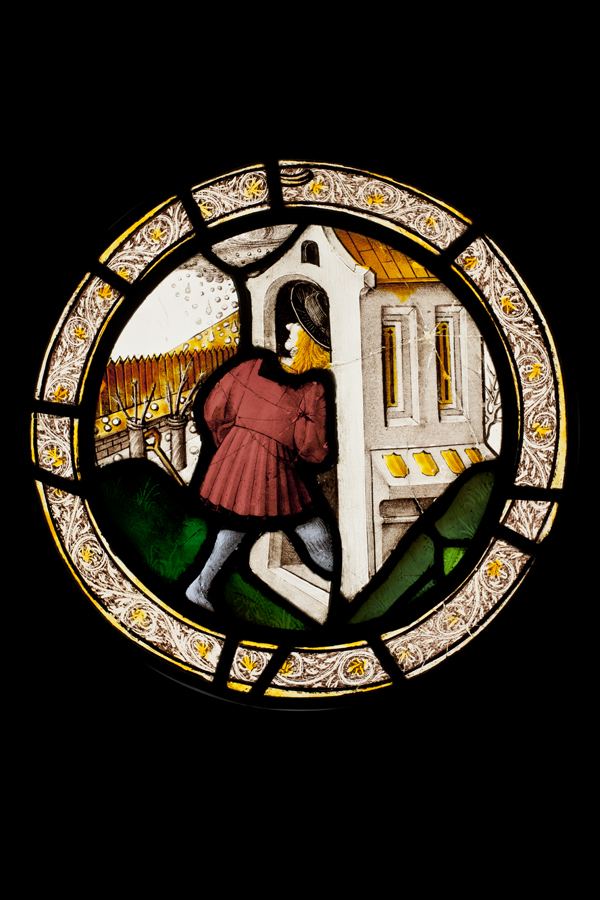roundel
Accession Number NWHCM : 2012.122
Description
roundel from set depicting Labours of the Months; man in red tunic and black hat goes into building to shelter from rain or hail, leaving plants in pots and a spade; may represent month of April or November
Read Moreroundel
This is one of four roundels from a surviving set of eight depicting the popular medieval subject of the Labours of the Months. Originally there would have been twelve roundels – one to represent each month. The Labours of the Months was a common subject in both sacred and secular medieval art in Britain and in mainland Europe. No complete set of Labours survives in stained glass, in Norfolk or elsewhere. Usually only single panels exist in fragmentary condition. These roundels are in excellent condition given their age and fragility. Of this set of eight roundels, Norwich Castle has four, two are in a private collection (‘Mowing’ and ‘Harvesting’), while two are at the Victoria and Albert Museum (‘Sitting by the Fire’ and ‘Bathing’).
This scene may be meant to represent either April or November. A man puts down his spade and hurries off indoors to escape a sudden storm. It is unclear whether the large droplets represent rain, hail or even snow. The darkness of the porch emphasises the tilt of the gardener’s head as he looks over his shoulder at the sky. Details like these give the figures character and personality. It is possible that the image of a man sheltering from a storm is a particular feature of Norwich-made Labours, since this is the only county where its use is known.
There is a similar roundel for April with a man sheltering from the rain in St George’s church, Tombland, Norwich. In Britain, the month of April is known for its heavy downpours and hail, which is caused by the position of the jet stream. Showers were certainly associated with April during the medieval period in England – Geoffrey Chaucer began ‘The Canterbury Tales’, written between 1387 and 1400, with the sentence: "Whan that Aprill, with his shoures soote The droghte of March hath perced to the roote" (When April with its gentle showers has relieved March’s drought, getting down to the roots).
Although the example in St George’s church, Tombland, is slightly different in style, the similarity of these different roundels suggests that the glass makers who made them were working from established patterns. Pictorial sources for Norwich stained glass have not so far been traced. However it is probable that, once printing had become widespread in Britain and Europe by the turn of the sixteenth century, pattern books of printed images circulated between workshops. There is some intriguing evidence for this in the design of this roundel. The man sheltering from the storm bears a close resemblance to a fragmentary panel of the same subject now in Besthorpe church. Besthorpe also houses a fragment of another roundel in similar style, depicting a man holding an axe. This refers to the activity of ‘killing the pig’ which commonly appeared representing the month of October or November, and offers a vital clue to the subject of one of the lost roundels in this series.
These roundels are outstanding examples of early sixteenth century work of the Norwich school of stained glass making. All four have been composed with the highest artistic and technical skill. The faces are rendered with great character, and the figures show a strong Flemish influence in their high degree of naturalism. This is characteristic of Norwich-made glass at the beginning of the sixteenth century, at which point increasing awareness was shown of artistic influences from the Low Countries. There were strong trading and cultural links between Norfolk and the Low Countries at that time and for many centuries it was quicker to get from Norfolk to the Low Countries by sea than it was to travel to London by road.
The roundels are thought originally to have been made for Thomas Pykerell (d.1545), a Mercer, Sheriff and Mayor in Norwich. Pykerell became Sheriff in 1513 and was elected Mayor in 1525, 1533 and 1538. He is thought to have built his house in Rosemary Lane around the end of the fifteenth century. At that time domestic stained glass was a luxury. The commission of these roundels is symptomatic of the wealth and prosperity of merchants in Norwich at the height of the city’s commercial importance.
Pykerell’s House, bombed during the Second World War, has since been restored and is now a home again. It was converted into a pub in the mid-19th century. At this point the roundels were removed, four were lost, and eight installed at a stately home, Brandiston Hall in central Norfolk, until 1985. They remained in private ownership until 2011, when they were put up for sale and four - February, April / November, September and December – were bought by Norfolk Museums Service.


